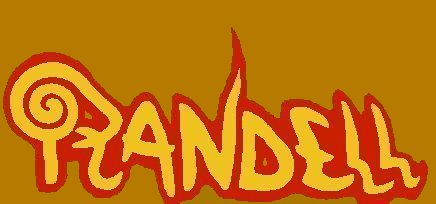
self reflecting ©

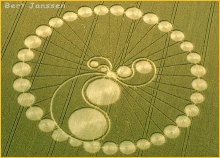
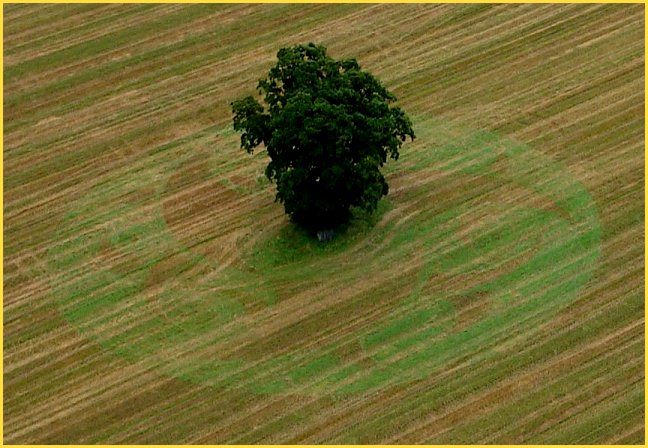
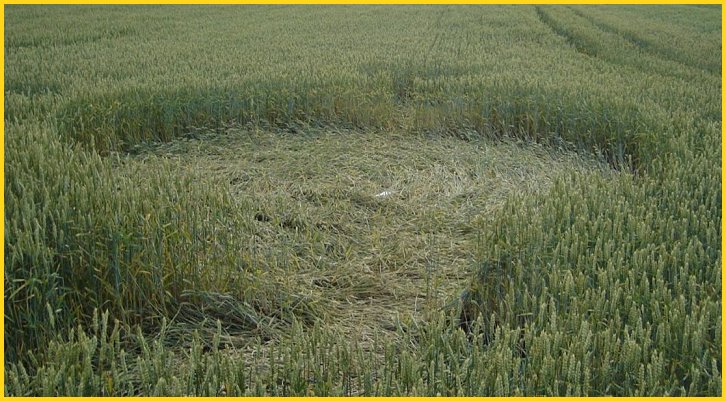
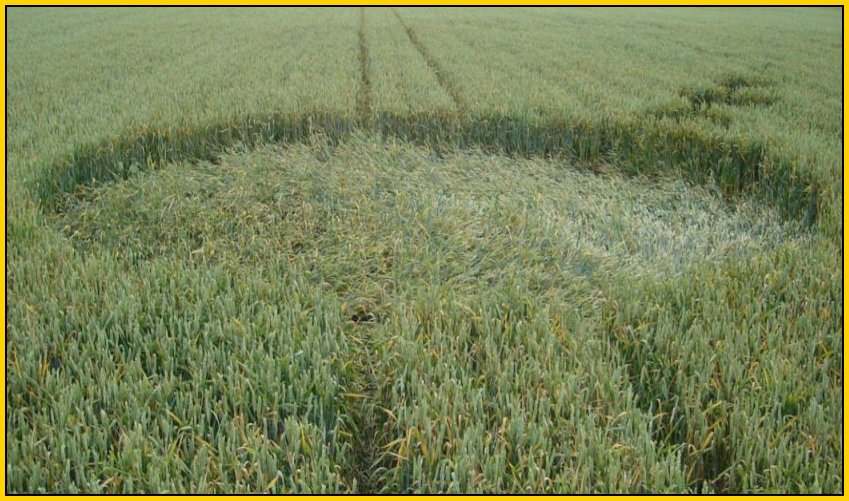
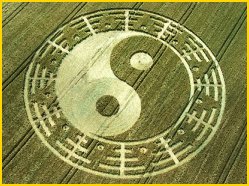
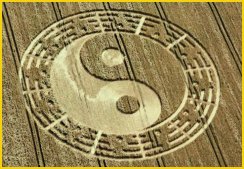
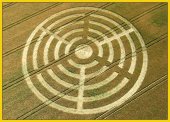
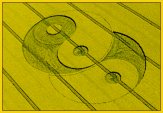
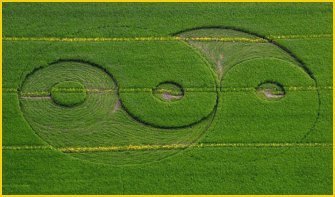
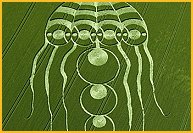
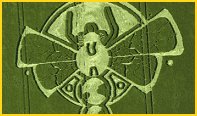
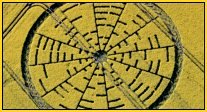
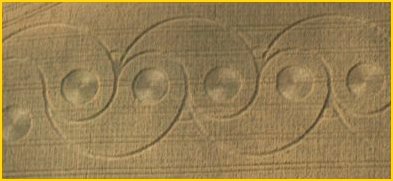
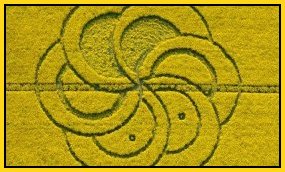
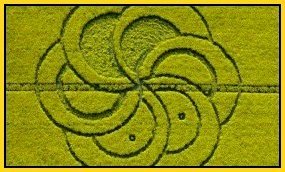
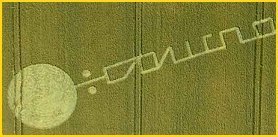
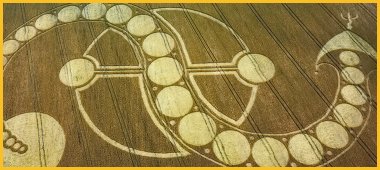
|
CROPCIRCLE RESEARCH
Silbury Hill, april 29th 2011. (part 2)
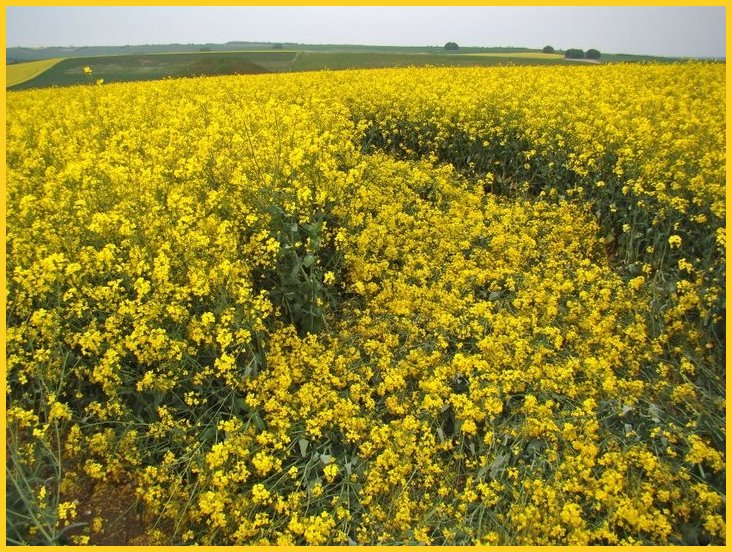
Silbury Hill formation one day after its discovery. © Susan Roghair
On the face of it, the comparison between the wall painting and the Silbury Hill
formation leaves us with a similarity that I would call neither strong nor weak.
It doesn't prove a real convincing link between the two, in that sense that the
crop formation would with purpose intent direct to the wall painting. But that's
just on the face of it…
Normally, at any given comparison, people automatically search for similarities.
In this case it is clear there are, but there are also quite a lot of differences.
In case, when one is alert enough to also pay attention to the differences, than
remarkable insights will be found. To begin with, there are some typical oppositional
imagery elements involved. At least four!
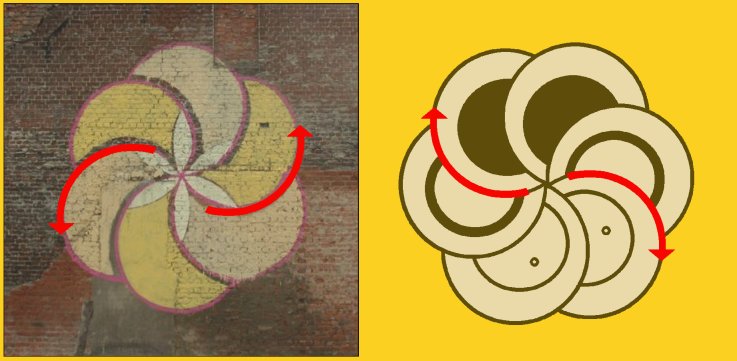
First of all, there's the obvious difference of turning direction that is suggested
by the curves that emanate from the centre. In the wall painting, this direction
goes against the clock. In the formation the turning direction goes wíth the clock.
So, that’s clearly opposite to each other.
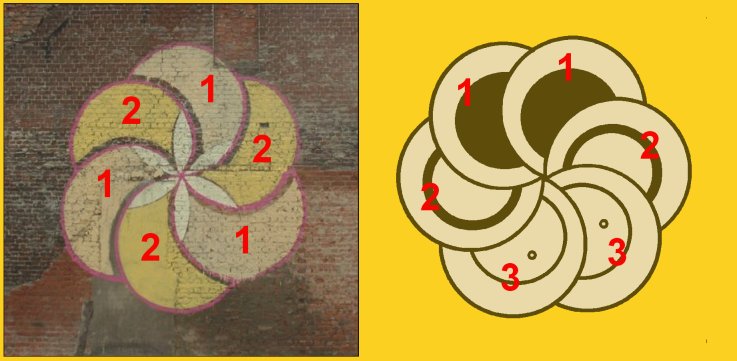
Another difference concerns the number of characteristics within the six parts. In
the wall painting I have only made two different types of parts. These are light
yellow parts and dark yellow parts. The characteristics have thus been defined by
the tone of colour. In this comparison, the light yellow parts I have given the
number 1. The darker yellow parts have number 2. All together, we notice 3 times
two different parts.
In the formation the exact opposite appears. It happens to be that in it, there
are two times three different parts! The characteristics have not been accentuated
by tone of colour, but by different shapes. As we speak, there is the shape that
can represent "completion". There is the shape that can represent the "limitation"
character. And there is the shape of "initiation".
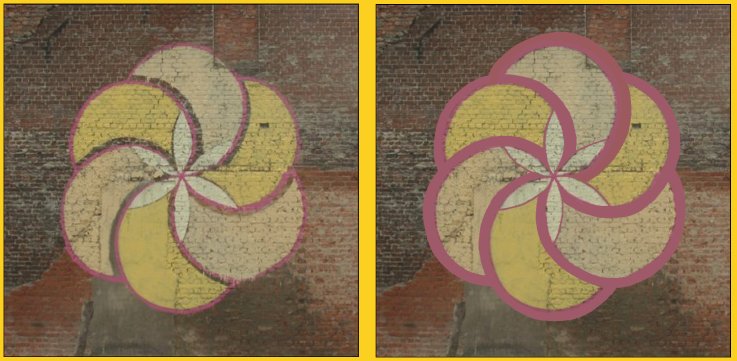
Left: The Wall painting unfinished. Right: As meant to be. (Photo shopped)
The third opposite is a little harder to recognise because of the fact that the wall
painting is not totally finished. I have to admit, the silly police action has had
a negative effect on my motivation here. Anyway, the opposite here, tells about the
covering curves that form the parts. In the wall painting these curves are hardly
anything else but small lines. I intended to widen them up like has happened in the
original design.
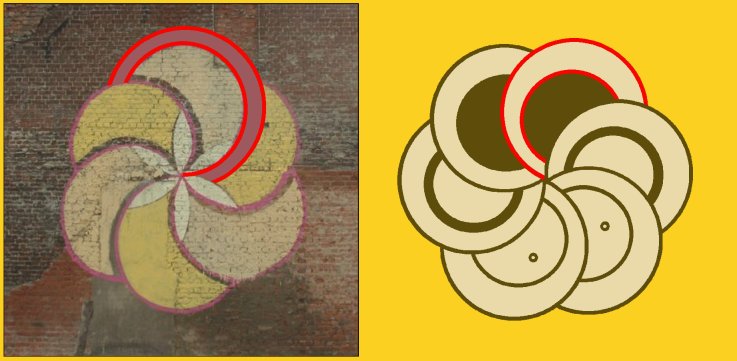
What we than see, is an outside and an inside at each curve. In my design aswell as
my wallpainting, the inside-lines start from the center. This opposite to the the
formation, where the outside-lines start from the center!
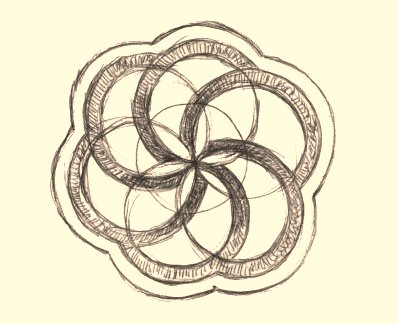
The original design sketch.
Is it the police repercussion that starts to itch, or is it the opposites that do so?
According to me, two more opposites can be pointed out in the comparency. We can
observe a horizontal seperation-line in the wallpainting. It is formed by the
unfinished demolishing of the house that used to be next to the house that still
exists. The line is in fact the upper side of a wall left over.
Held next to the picture of the formation, a similarity with the tramline becomes
clear. The lining of the walls looks a lot like the the lining in the field.
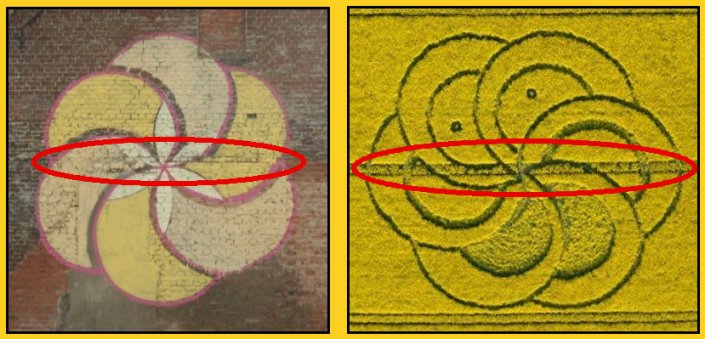
Both relate in a very interesting way to the centers. In the upper comparing
images we see in both cases the center of the figure positioned directly at
the bottom-side of the horizontal line. From the cropformation we cannot
understand what is to be considered above and below, if there is such at all.
The image of the cropformation is therefor allowed to be put upside down. In
that case we would notice the fourth opposite.
As obvious it remains unclear if we have found an opposite or similarity here.
Nevertheless, at the time I wrote this article I had a dream that indicated
that the turned around version, meaning the one with the exact midpoint just
above the horizontal line is the most correct. It is based on intuïtion that
make me assume the dream was related to the formation.
Another factor of meaning is about the turning of the figure in comparing with
the wallpainting. It may be so that we have found a similarity by the recognision
of a middle line, still it had to be so that this line bridges in one case the
shortest, and in the other case the longest possible distance! Again we have
gained an opposite!
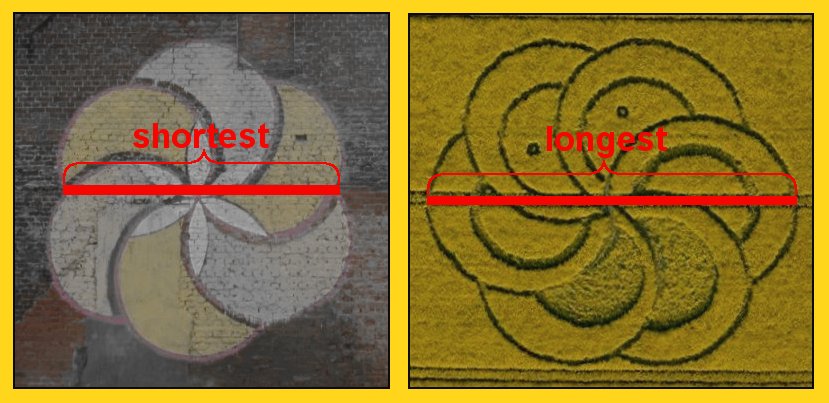
By now, we can conclude that the design of the Silbury Hill formation stands
in a much closer relationship to the wallpainting than superficially seen was
the case. It turnes out to be a play with opposites. That by itself is allready
so much more interesting than when a simple copy of the wallpainting would have
been appeared in the field.
Now we have this beautiful outcome, but it doesn't mean all the secrets of the
magic are revealed.
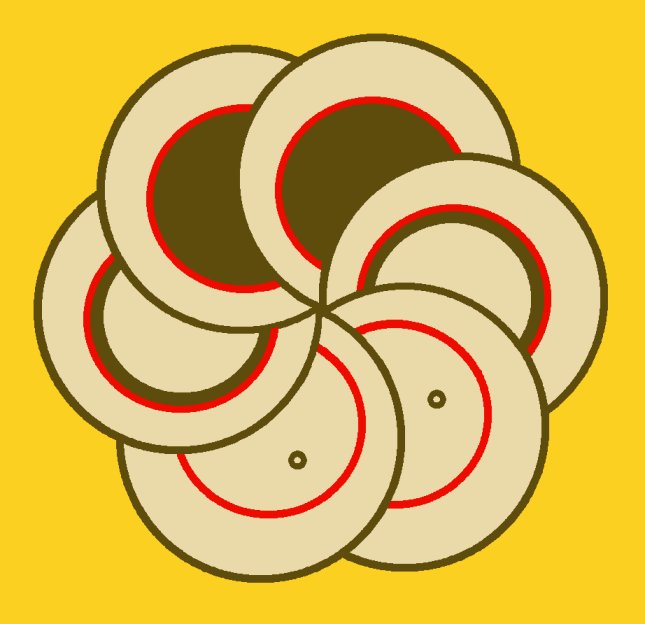
One of the seemingly weak aspects in the design of the cropformation, concerns
the placing of the "inside curves". One would expect the inside curves to be
parallel or concentric with the outside curves. That would look more esthetic
and that's how I have done it in my own design. Would I like to believe it is
the clumsiness of the cropcirclemakers than nothing more needs to be said. But
of course I would not like to believe so.
In case there's an reasonable explanation for the these non-concentric bendings,
than the answer lays in my original design. In it, I had made a fading effect in
between the inner and outer curves going from dark to light. This type of
accentuation might be very hard to reach in a canola field. The solution to this
problem could be, to create a fading track going from small to wide!
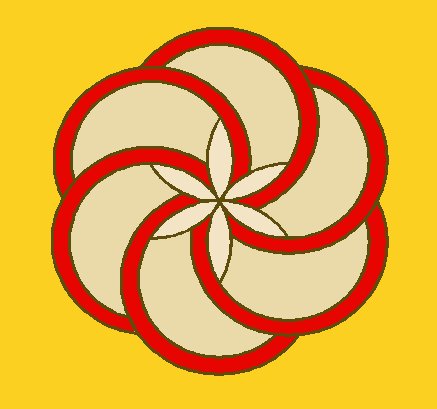
In the transmission from design to actual wallpainting I had descided to leave
the fading effect behind for practical reasons.
Something in the comparing of the wallpainting with the cropformation that
hasn't been given attention yet, is that the six petalled seed of life seems
to be absent. This is a remarkable difference that undermines the idea that
the Silbury Hill design can be based on the wallpainting.
But now that we have discovered so many relations between the two works of
art, my curiousity is tickled enough to find out, if there's a particular
reason for the fact that we haven't seen the little flower in the formation.
It speaks for itself, hopefully, that in the hidden structure of the formation,
the litlle flower of life can be found indeed. The outside curves only have to
be enlarged to complete circles to discover it. The possibility to show the
seed of life (little flower) didn't have to be very difficult it seems. It is
because of that, that, in search for an explanation, I have more interest in
the inside curves. I want to know what they will do when enlarging these curves
to circles…
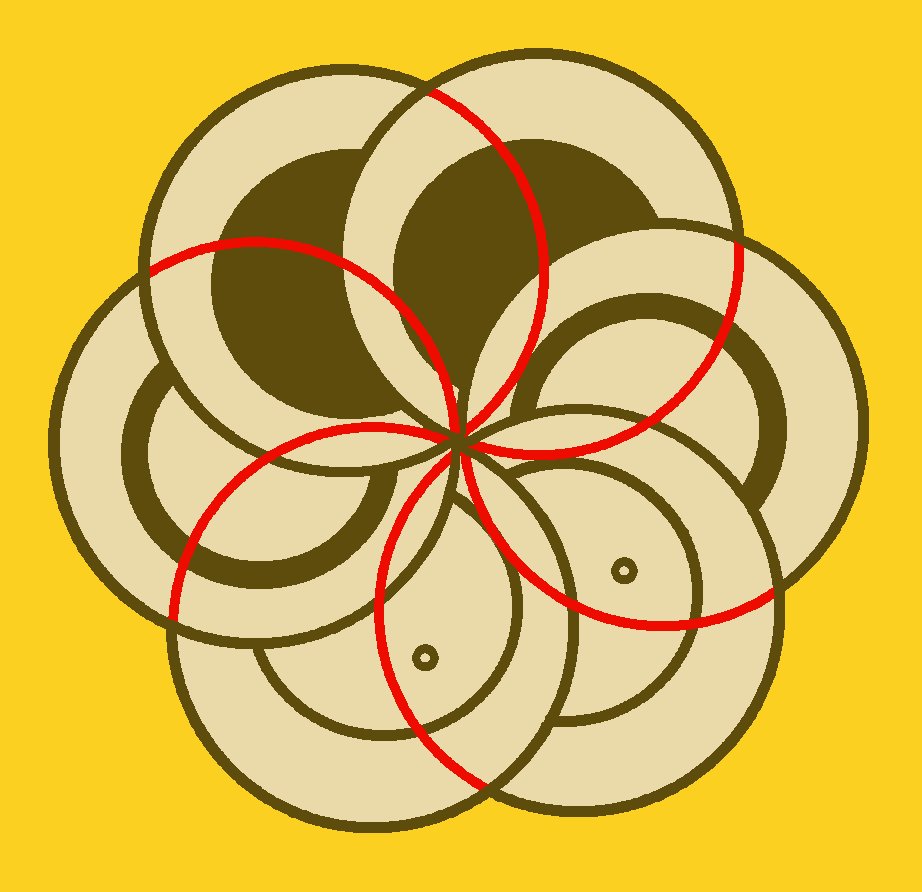
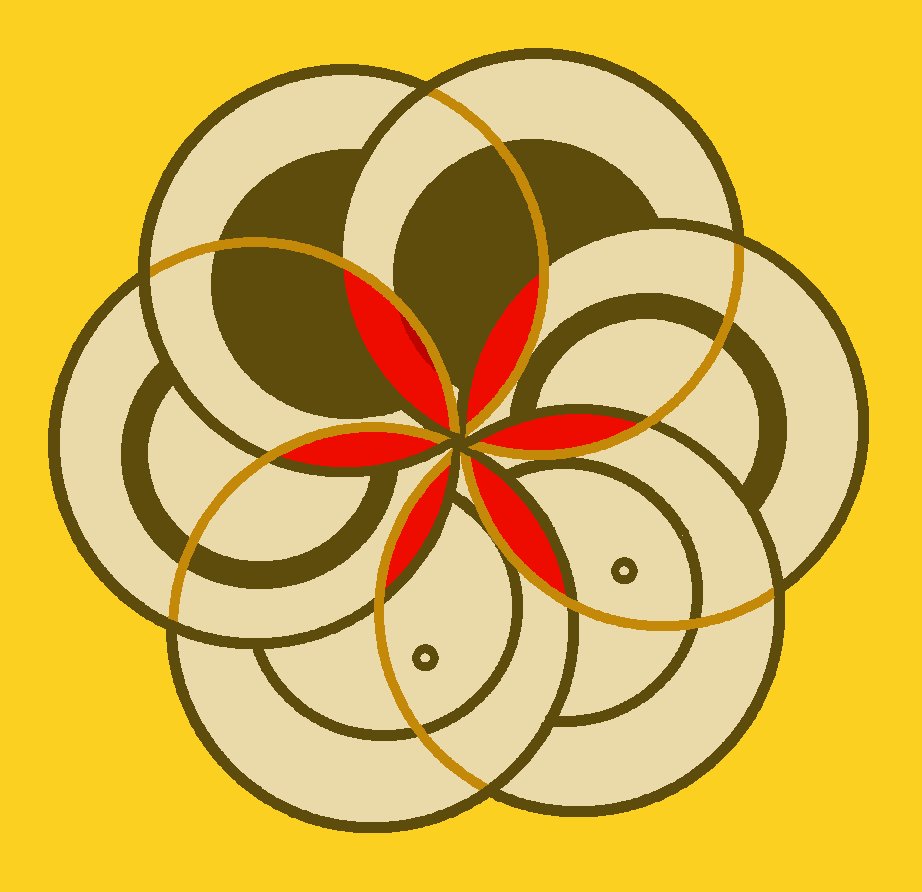
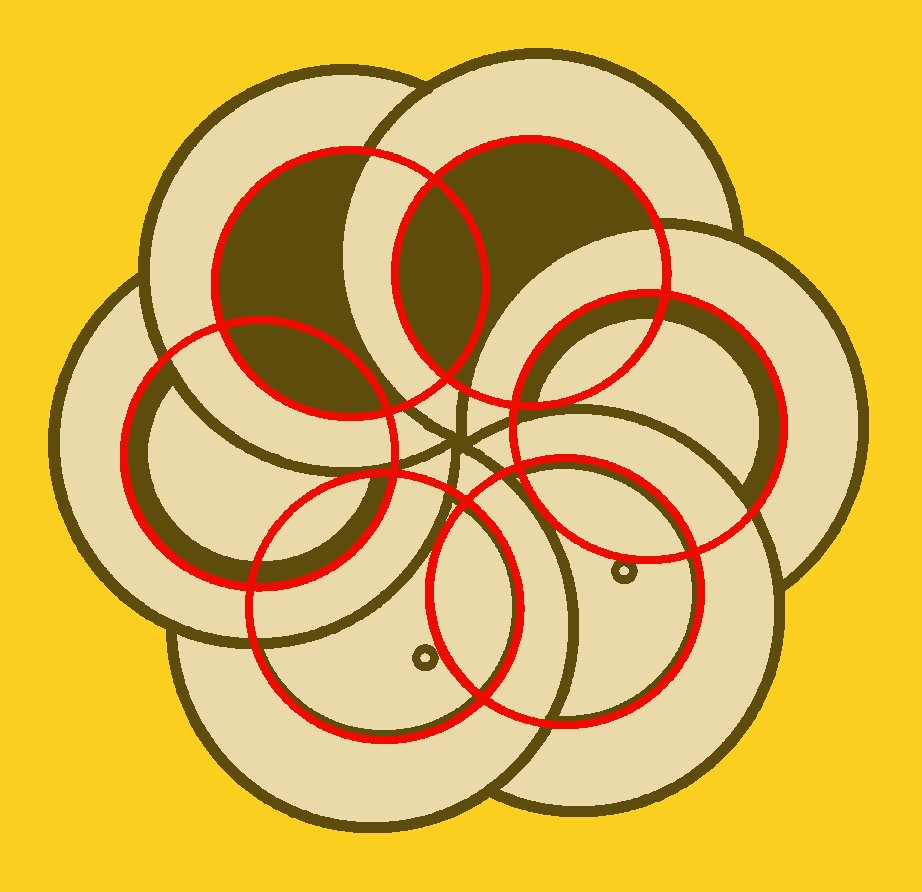
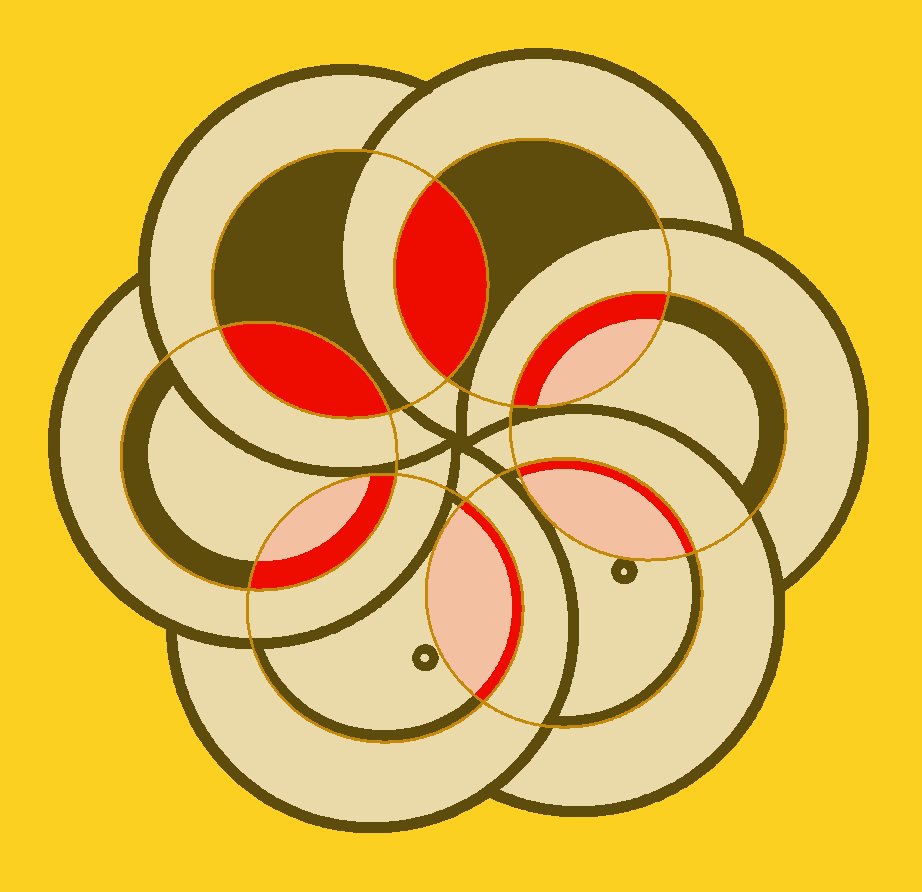
In case we try to find the petals back in the overlapping inside circles, than
we notice, not totally unexpected, the influence of the 2 x 3 different
characteristics. The characteristics seem to be in close relationship to the
new found petals! What strikes the most, is how the two little points, or small
rings in fact, are attached to two of these petals.
For a better overview, I tear the two groups apart from each other. That way,
we discover how a group of three different circles interact upon another group
of three different circles. It is almost bizarre how the three different
characteristics attend us on the possibility of six different circles! The
application of transparency has caused that not one of the circles is similar
to another.
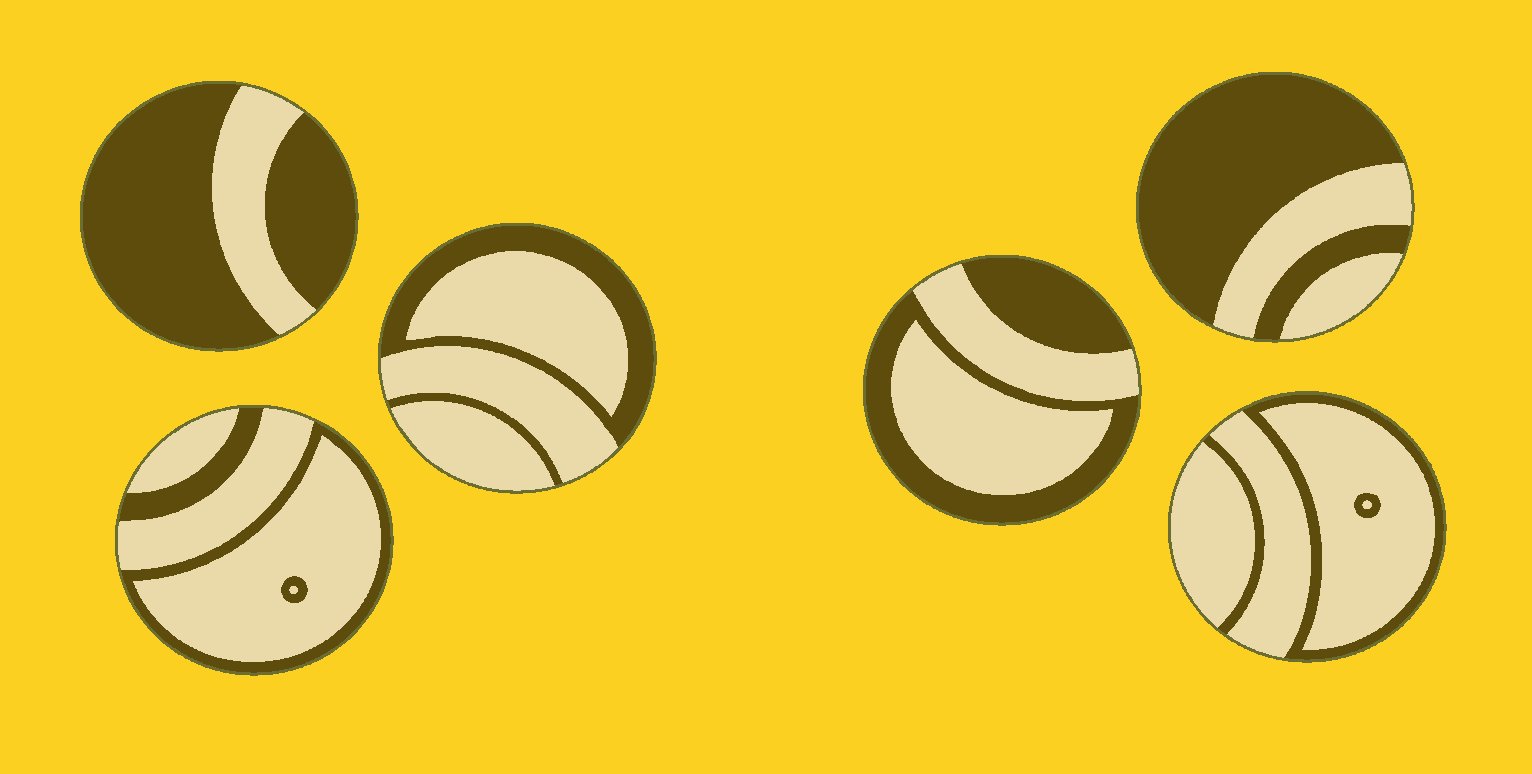
Without concerning the influence of transparency, we would keep the original
thought about two times three different circles.
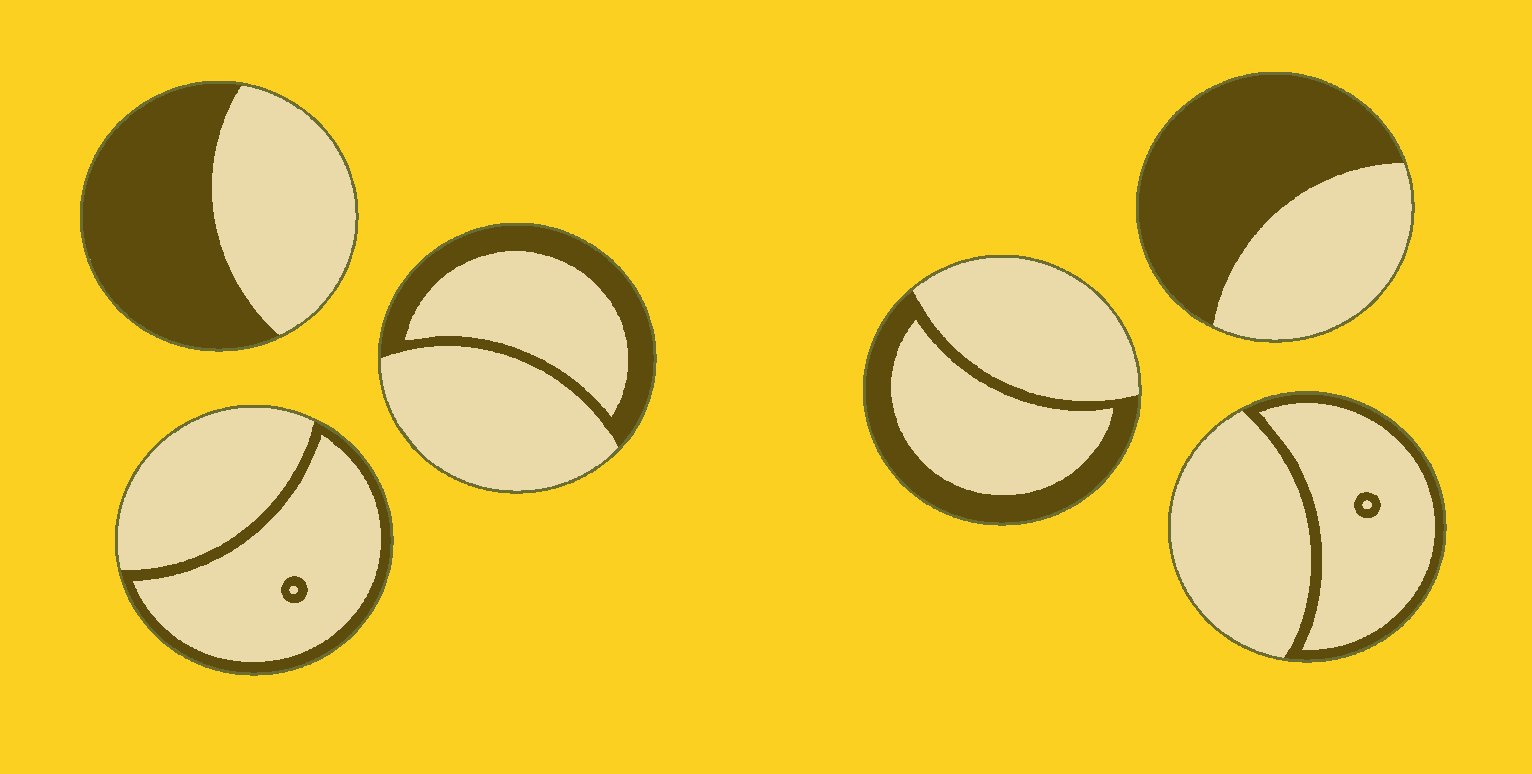
In fact, the characteristic differences as given above are not yet optimal.
The influence of transparency may have been annihilated, one can easily accept
that the moonlike shapes are caused by overlap. The circles undone from that
overlap effect look as followed:
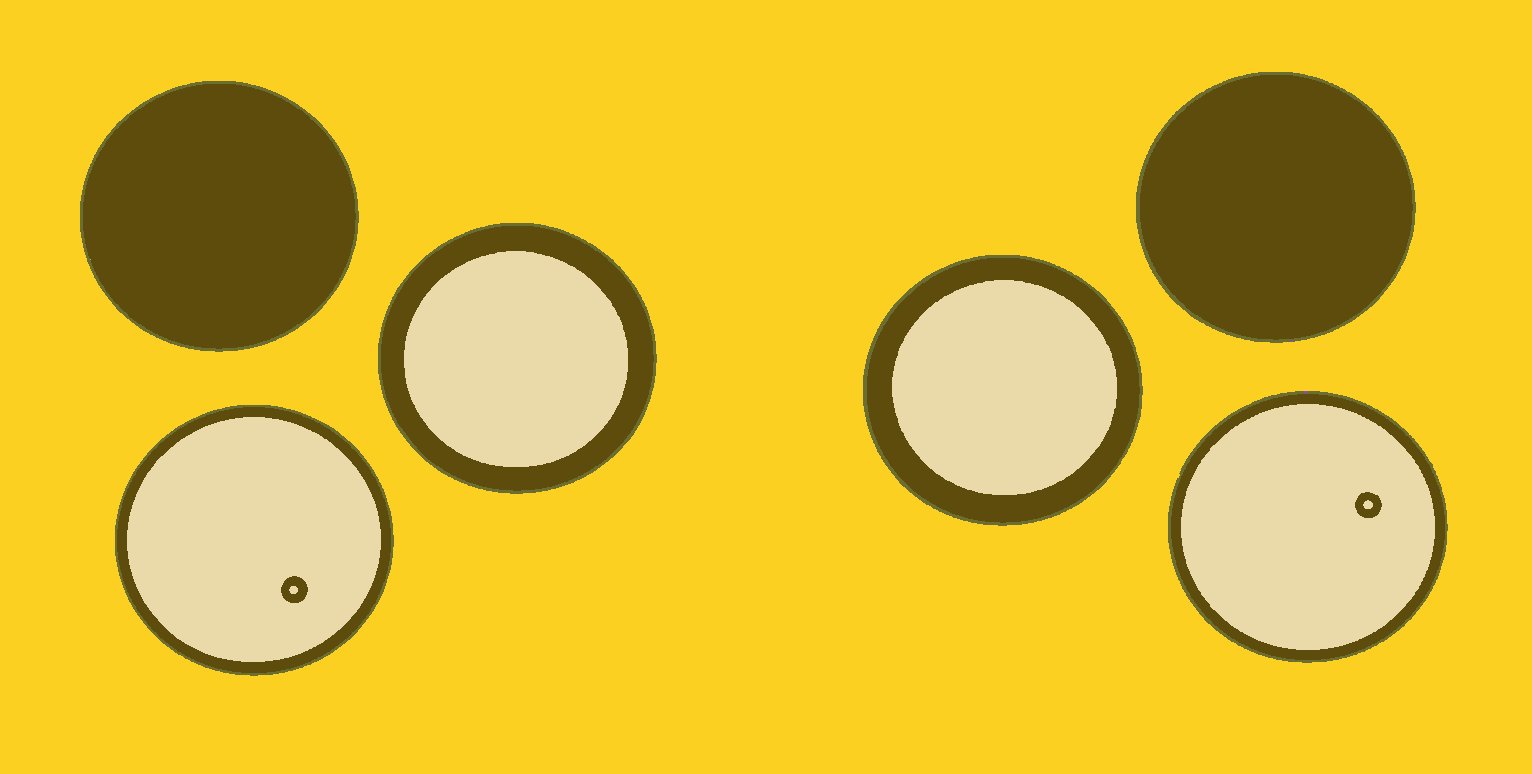
In the way we look at the circles this time, no terms like crescents or parts
can be used. No petals either. The material contains of three original elements.
It brings us, after a long investigational trip back to what could be seen at
the start anyway; the three different and oh so prominent characteristics! The
meaning of these have to be of crucial importance. But what are they really
telling us? The earlier associations; "initiation, limitation and completion",
feel like approaches. I have reached out for a more satisfying explanation, but
I won't give that track as many words as I did with the original version written
in Dutch.
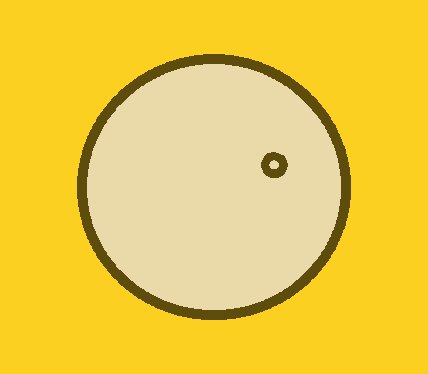 About the circle with the dot, it can be said that the dot is actually not a
point, but a very little empty circle. A little ring so to speak. Would it
be a point indeed, than the earlier idea of "initiation", would have been
enough accurate. Now at closer inspection I have interpreted it as potency
or maybe even better as "a possibility".
The little rings where originally attached to a neighbouring petal or circle,
but since no petals or completed circles have formed in the end result, they
seem to flow freely. I consider this very meaningful. It tells us in fact
about a hidden relationship. Or if not, a certain relationship, that has ended.
Also bare in mind, that no matter how small these rings look like, they dominate
by attracting attention in a very powerful way.
Another very intriguing association with these two rings is of "wedding-rings".
Permit it a serious thought. The date of appearance of the formation was
April 29th 2011. The world that day seemed under the spell of the fairy
tale marriage of Prince William with middle-class girl Kate! It is already
been said the marriage of the century!
About the circle with the dot, it can be said that the dot is actually not a
point, but a very little empty circle. A little ring so to speak. Would it
be a point indeed, than the earlier idea of "initiation", would have been
enough accurate. Now at closer inspection I have interpreted it as potency
or maybe even better as "a possibility".
The little rings where originally attached to a neighbouring petal or circle,
but since no petals or completed circles have formed in the end result, they
seem to flow freely. I consider this very meaningful. It tells us in fact
about a hidden relationship. Or if not, a certain relationship, that has ended.
Also bare in mind, that no matter how small these rings look like, they dominate
by attracting attention in a very powerful way.
Another very intriguing association with these two rings is of "wedding-rings".
Permit it a serious thought. The date of appearance of the formation was
April 29th 2011. The world that day seemed under the spell of the fairy
tale marriage of Prince William with middle-class girl Kate! It is already
been said the marriage of the century!
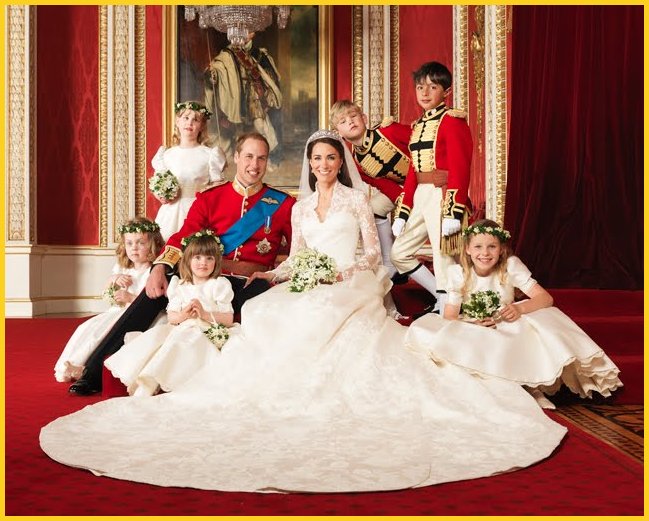
The Royal Marriage.
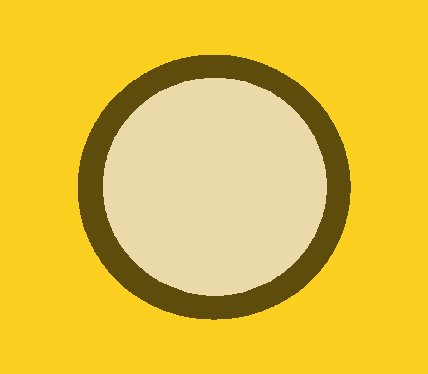 The next characteristic I have called "limitation". It could also be related
to the idea of contraction or "giving in". These idea's I have based on the
curve line of which its thickness is expanded inwards.
The next characteristic I have called "limitation". It could also be related
to the idea of contraction or "giving in". These idea's I have based on the
curve line of which its thickness is expanded inwards.
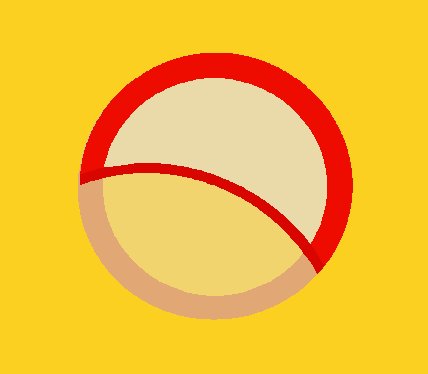
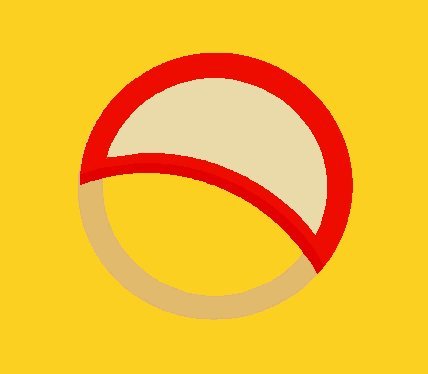
Left: diagram a. Right: diagram b.
Not only does this thicker curve lead us to the suggestion that it continues
underneath the following circle (diagram a), it also demonstrates interesting proportions
when it shines through a hidden petal.(diagram c) To be more precise, I wonder about the
volume of this petal. Does the line fill it up exactly halfway? (diagram d)
Diagram b
represents the thicker outlines of a cresent in case such was wanted to be expressed.
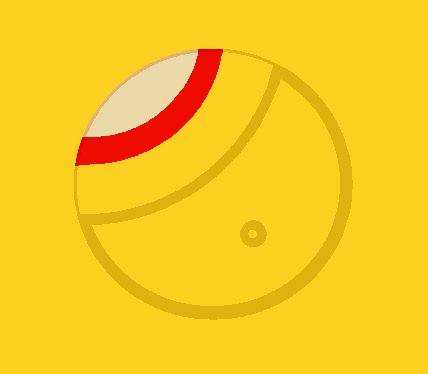
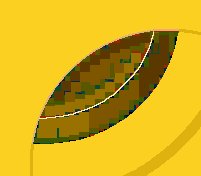
Left: diagram c. Right: diagram d.
A third aspect is that it seems doubled in thickness. It could remind us to
the little ring. As if it has expanded to its outer limit! The little ring is
the smallest possible ring. Becoming smaller would make it a disk or a point,
not a ring. The expanded ring is the widest possible ring. These extremes in
small and wide directly bounce me back to the beginning of my wall painting
design. I used Hackpen Hills crop formation of 2008 as inspiration.
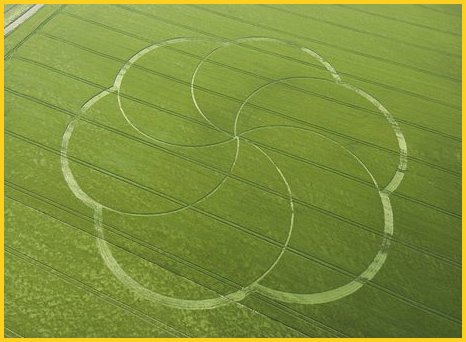
Hackpen Hill, 2008. Photograph © Steve Alexander.
It is said that this formation is about the human ability to observe the
smallest as well as the widest! With only a single isolated stalk in the
exact centre of this incredible huge formation it will certainly be more
than ordinary rumour.
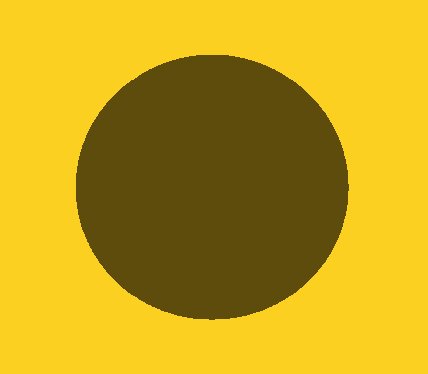 The third characteristic, I presume represents in all its simplicity, the
completion of the earlier two characteristics. "Satiation" or "saturation"
I would choose as keywords for it.
As the three characteristics seem to relate to each other in a logistic or
progressive order it becomes clear that each set of three is about a certain
development. With two of likely the same developments in one pictogram, we
may wonder about the particular type of development that is involved.
In case the idea of marriage is intended to take a closer look at by this
formation, one might say that maybe two weddings are under our attention.
The royal wedding of William and Kate came to show us only one wedding-ring.
Therefore it is a little doubtful to take the two developments for the
developments of the two candidates themselves. The development concerns
more likely one marriage as a whole.
The third characteristic, I presume represents in all its simplicity, the
completion of the earlier two characteristics. "Satiation" or "saturation"
I would choose as keywords for it.
As the three characteristics seem to relate to each other in a logistic or
progressive order it becomes clear that each set of three is about a certain
development. With two of likely the same developments in one pictogram, we
may wonder about the particular type of development that is involved.
In case the idea of marriage is intended to take a closer look at by this
formation, one might say that maybe two weddings are under our attention.
The royal wedding of William and Kate came to show us only one wedding-ring.
Therefore it is a little doubtful to take the two developments for the
developments of the two candidates themselves. The development concerns
more likely one marriage as a whole.
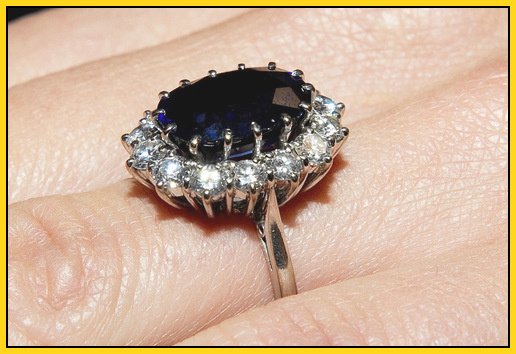
The wedding ring.
So what other marriage could be referred
to than? It is simple. Another Royal wedding took place the same season. It
was the marriage of Prince Albert and Charlene Wittstock in Monaco. In case
you still doubt the crop circle makers would reflect on these events, than
just take a quick look at the following formation:

Barbury Castle, July 2nd 2011 © Oliver Morel.
It was discovered on the same day of the Royal wedding in Monaco. Although
it appeared in England as most usual, it is definitely able to represent a
logo or magic banner for marriage. As it is very easy to see two persons in
opposition (light and dark) with each other, becoming united, it looks very
appealing. I personally would call it "embracement" I believe.
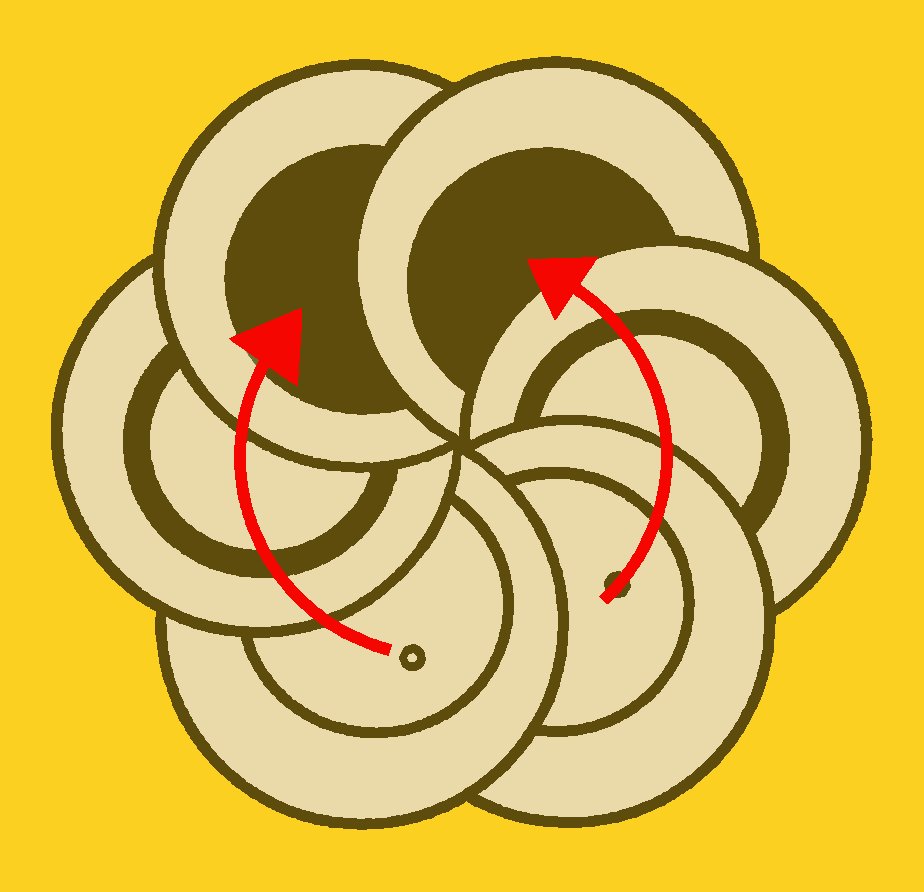
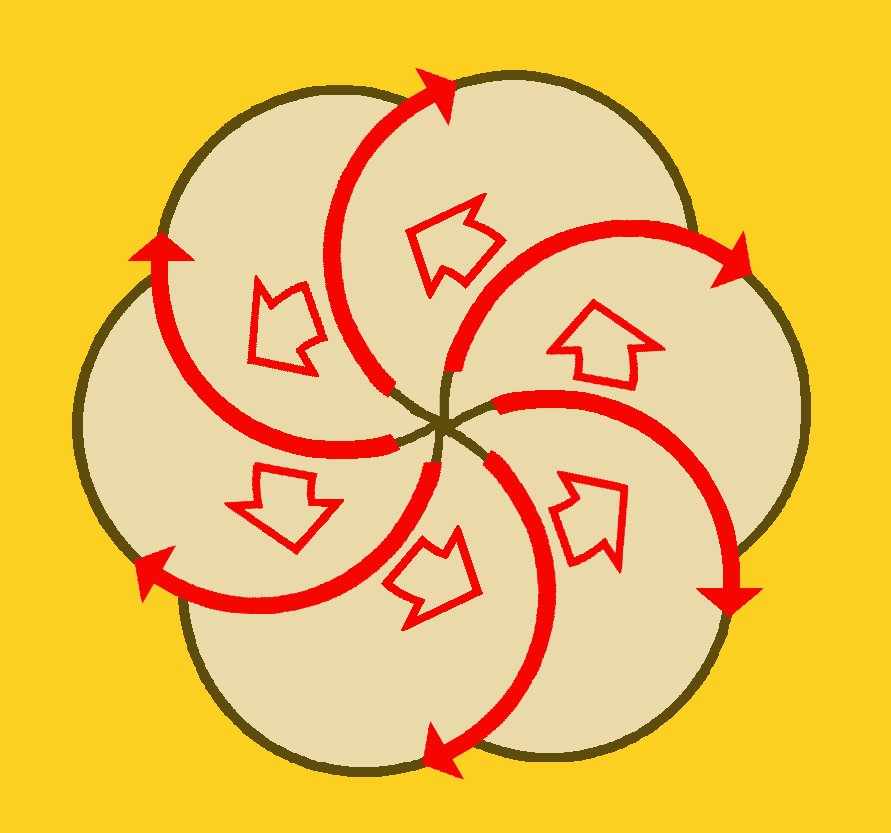
More aspects of the Silbury Hill formation concern the directions of flow
in connection with the suggestion of a turning movement. It has leaded me
to the principle of succession.
This article will tell you more
about succession in relation to cropcircle language. I will also be short on
this, but summarise with stating that two developments
seem expressed. One is going with the flow, the other against it. It depends
on the perception of what should be considered the natural flow which
direction is taken…
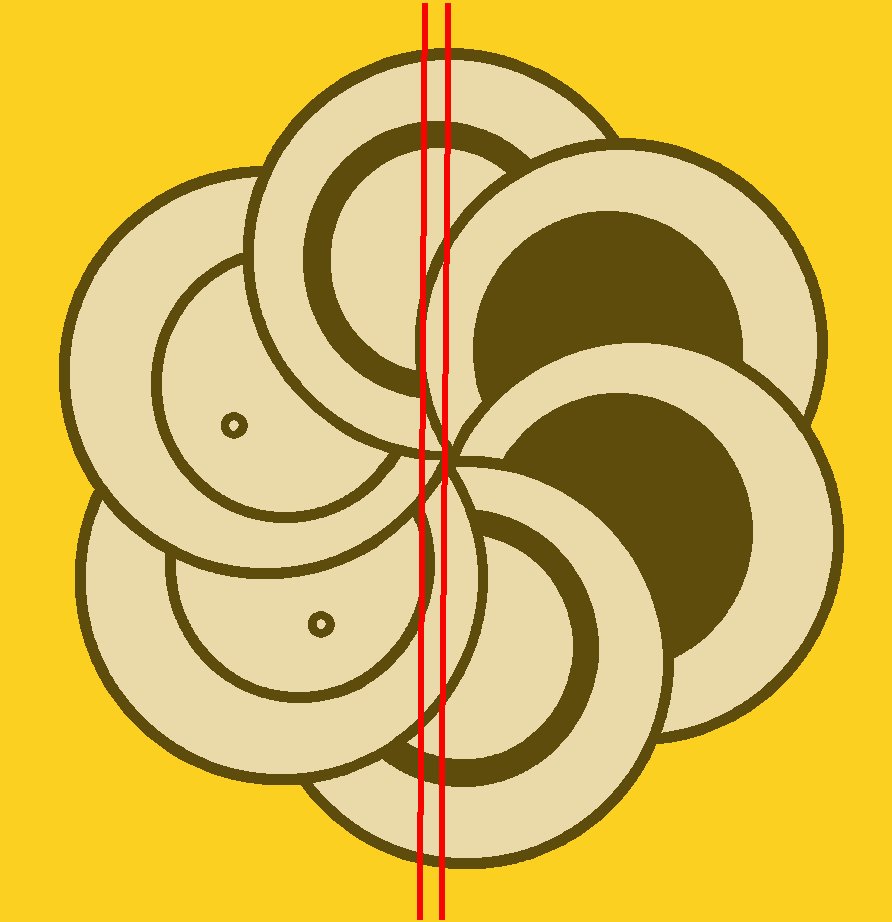
Another aspect seems to direct to the Kabbalistic pillars of balance and all
that is related to them. I leave this as a hint, that's all for now. In the
next article more about duality and unity will be considered.
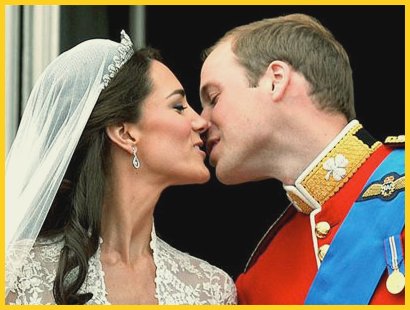
Renewal on the relational plane involves change in powerstructure.
|




 About the circle with the dot, it can be said that the dot is actually not a
point, but a very little empty circle. A little ring so to speak. Would it
be a point indeed, than the earlier idea of "initiation", would have been
enough accurate. Now at closer inspection I have interpreted it as potency
or maybe even better as "a possibility".
The little rings where originally attached to a neighbouring petal or circle,
but since no petals or completed circles have formed in the end result, they
seem to flow freely. I consider this very meaningful. It tells us in fact
about a hidden relationship. Or if not, a certain relationship, that has ended.
Also bare in mind, that no matter how small these rings look like, they dominate
by attracting attention in a very powerful way.
Another very intriguing association with these two rings is of "wedding-rings".
Permit it a serious thought. The date of appearance of the formation was
April 29th 2011. The world that day seemed under the spell of the fairy
tale marriage of Prince William with middle-class girl Kate! It is already
been said the marriage of the century!
About the circle with the dot, it can be said that the dot is actually not a
point, but a very little empty circle. A little ring so to speak. Would it
be a point indeed, than the earlier idea of "initiation", would have been
enough accurate. Now at closer inspection I have interpreted it as potency
or maybe even better as "a possibility".
The little rings where originally attached to a neighbouring petal or circle,
but since no petals or completed circles have formed in the end result, they
seem to flow freely. I consider this very meaningful. It tells us in fact
about a hidden relationship. Or if not, a certain relationship, that has ended.
Also bare in mind, that no matter how small these rings look like, they dominate
by attracting attention in a very powerful way.
Another very intriguing association with these two rings is of "wedding-rings".
Permit it a serious thought. The date of appearance of the formation was
April 29th 2011. The world that day seemed under the spell of the fairy
tale marriage of Prince William with middle-class girl Kate! It is already
been said the marriage of the century!

 The next characteristic I have called "limitation". It could also be related
to the idea of contraction or "giving in". These idea's I have based on the
curve line of which its thickness is expanded inwards.
The next characteristic I have called "limitation". It could also be related
to the idea of contraction or "giving in". These idea's I have based on the
curve line of which its thickness is expanded inwards.





 The third characteristic, I presume represents in all its simplicity, the
completion of the earlier two characteristics. "Satiation" or "saturation"
I would choose as keywords for it.
As the three characteristics seem to relate to each other in a logistic or
progressive order it becomes clear that each set of three is about a certain
development. With two of likely the same developments in one pictogram, we
may wonder about the particular type of development that is involved.
In case the idea of marriage is intended to take a closer look at by this
formation, one might say that maybe two weddings are under our attention.
The royal wedding of William and Kate came to show us only one wedding-ring.
Therefore it is a little doubtful to take the two developments for the
developments of the two candidates themselves. The development concerns
more likely one marriage as a whole.
The third characteristic, I presume represents in all its simplicity, the
completion of the earlier two characteristics. "Satiation" or "saturation"
I would choose as keywords for it.
As the three characteristics seem to relate to each other in a logistic or
progressive order it becomes clear that each set of three is about a certain
development. With two of likely the same developments in one pictogram, we
may wonder about the particular type of development that is involved.
In case the idea of marriage is intended to take a closer look at by this
formation, one might say that maybe two weddings are under our attention.
The royal wedding of William and Kate came to show us only one wedding-ring.
Therefore it is a little doubtful to take the two developments for the
developments of the two candidates themselves. The development concerns
more likely one marriage as a whole.






































